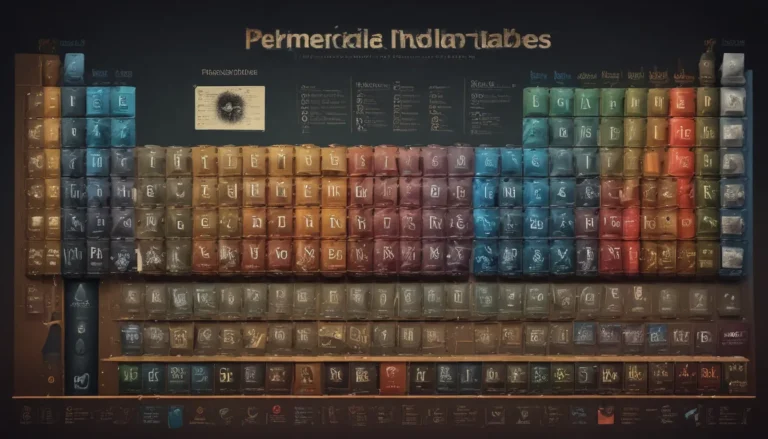A Note About Images: The images used in our articles are for illustration purposes only and may not exactly match the content. They are meant to engage readers, but the text should be relied upon for accurate information.
Are you intrigued by the wonders of chemistry? Have you ever pondered about the captivating phenomenon known as freezing point depression? This enchanting effect has revolutionized various industries, from medicine to food preservation and materials science. In this article, we will embark on a journey to explore 12 extraordinary facts surrounding freezing point depression. Prepare to be amazed as we uncover the underlying principles, real-world applications, and intriguing examples of this fascinating phenomenon.
Illuminating the Phenomenon of Freezing Point Depression
Freezing point depression is a captivating occurrence in the realm of chemistry, where the freezing point of a solvent decreases upon the addition of a solute. This fundamental concept holds substantial significance across diverse fields such as biochemistry, pharmaceuticals, and environmental science. Let’s unravel 12 astounding facts about freezing point depression to broaden our insights into this captivating phenomenon.
Understanding the Colligative Property of Freezing Point Depression
A pivotal factor contributing to freezing point depression is the colligative property. This property dictates that the extent of freezing point depression is solely influenced by the number of solute particles present, irrespective of their nature.
Delving into Vapor Pressure Lowering
The disruption of the solvent’s crystal lattice formation by solute particles leads to freezing point depression by reducing its vapor pressure. Consequently, the solvent necessitates a lower temperature to reach its freezing point.
Exploring the Molal Freezing Point Depression Constant
Every solvent boasts its unique Molal Freezing Point Depression Constant (Kf), serving as a gauge of how much the solvent’s freezing point diminishes with the addition of a solute.
Unveiling the Depression of Freezing Point in Solutions
In the realm of solutions, the introduction of a non-volatile solute prompts a decrease in the freezing point of the resultant solution. The intensity of freezing point depression escalates with higher solute concentrations.
Connecting Freezing Point Depression with Osmotic Pressure
There exists a close relationship between freezing point depression and osmotic pressure. Osmosis transpires when a semipermeable membrane encounters a disparity in solute concentration, inducing the movement of solvent molecules to maintain equilibrium.
Shedding Light on the Cryoscopic Constant
The Cryoscopic Constant (Kc) serves as an alternate term denoting the extent of freezing point depression in a specific solvent, exhibiting a direct correlation with the solute’s molal concentration.
Practical Applications in Antifreeze Solutions
The practical implications of freezing point depression manifest in the formulation of antifreeze solutions. By incorporating substances like ethylene glycol into water, the freezing point of the solution is depressed, allowing it to retain a liquid state even amid frigid temperatures.
Significance in Food Preservation
Freezing point depression assumes a pivotal role in food preservation by averting the formation of sizable ice crystals detrimental to food quality. For instance, the addition of salt to an ice bath diminishes the ice’s melting point, facilitating superior preservation of perishable items.
Unraveling Freezing Point Depression and Molecular Weight Determination
Scientists harness the phenomenon of freezing point depression to ascertain the molecular weight of unknown substances. By gauging the extent of freezing point depression, they can deduce the number of solute particles present, thereby inferring the molecular weight.
Impact of Solute-Solvent Interactions on Freezing Point Depression
The magnitude of freezing point depression hinges on the nature of solute-solvent interactions. Strong interactions between the solute and solvent accentuate freezing point depression.
Harmonizing with the Laws of Thermodynamics
Freezing point depression adheres to the principles of thermodynamics, reflecting a decline in the system’s Gibbs free energy. This signifies a more stabilized state of the solution in comparison to the pure solvent.
Embarking on a New Dawn of Discovery
In essence, the realm of freezing point depression epitomizes a captivating concept with multifaceted applications in the domains of science and technology. By unraveling the intricate interplay of solute particles and solvent freezing points, scientists and researchers forge innovative pathways, refine processes, and elevate the efficacy of a myriad of products.
From forging antifreeze solutions to fostering the creation of cryogenic materials, the exploration of freezing point depression heralds groundbreaking breakthroughs and advancements. By harnessing this scientific tenet, a realm of endless possibilities unfolds, propelling us towards uncharted frontiers in chemistry, medicine, and engineering.
FAQs
- What is freezing point depression?
-
Freezing point depression denotes the phenomenon where the freezing point of a solvent decreases upon the addition of a solute.
-
How does freezing point depression occur?
-
The introduction of a solute disrupts the regular crystal lattice structure of the solvent, impeding solvent molecules from orderly arrangement during freezing, culminating in a lowered freezing point.
-
What are some practical applications of freezing point depression?
-
Freezing point depression finds utility in producing antifreeze solutions, preserving food through freezing, cryopreservation of biological materials, and various industrial processes necessitating low-temperature environments.
-
How is freezing point depression calculated?
-
The freezing point depression can be calculated using the equation: ΔT = Kf * m * i, wherein ΔT signifies the freezing point change, Kf denotes the cryoscopic constant, m represents the solute’s molality, and i reflects the van’t Hoff factor.
-
Are there any limitations to freezing point depression?
- While freezing point depression is a valuable phenomenon, it hinges on ideal conditions and assumes ideal solutions. Deviations from ideal behavior can influence the precision of calculations and projections.
Embark on a journey of scientific discovery as freezing point depression unveils its enigmatic properties, crafting solutions that defy freezing and revolutionizing realms from engine protection with antifreeze to molecular weight determinations. Embrace the world of freezing point depression to safeguard food quality and delve into the essence of solute concentration’s influence on freezing point depression. Unravel the tapestry of practical applications and scientific wisdom that this captivating phenomenon bestows upon us.
Through our unwavering commitment to delivering authentic and engaging content, we embrace a tapestry of insights contributed by individuals like you, fostering a rich platform for diverse knowledge and information. Rely on our steadfast dedication to credibility and excellence as you venture through the realms of learning and exploration with us.





